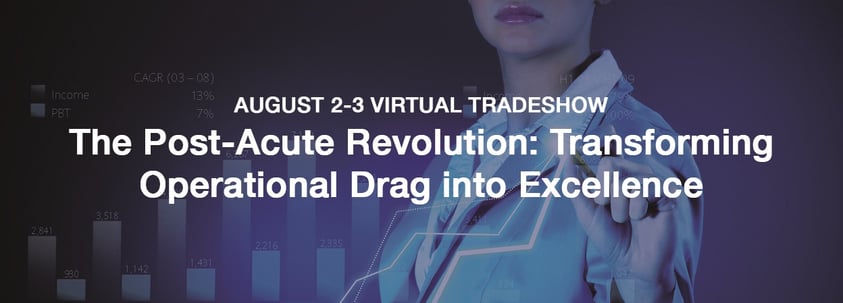|
Join us for Prime Care Technologies' August 2-3 Virtual Tradeshow. This show features seven strategic sessions with top post-acute providers and vendors who will discuss highly-efficient solutions for meeting your operational demands in purchasing, regulatory, staffing, revenue, claims and more. Wednesday, August 210:30-11:30 a.m. ETExecutive Decision-Making: Leveraging Facility Data as Business IntelligenceSpeaker: Kim Sonderegger, Pinnacle Quality Insight Panel: Samantha Broussard, Plantation Management; Eric Rivard, Plum Healthcare Group, Cheryl Field, Prime Care Technologies 12:30-1:30 p.m. ETE-Procurement: Innovative Management of Healthcare SpendSpeaker: Jessica Spencer, Medline Industries Panel: Pam Mink, Foundation Health Services and Rusty Zosel, Procurement Partners 2-3 p.m. ETCMS Requirements for Participation: Need-to-Know Compliance Tips for Long-Term CareSpeakers: Clifton Porter, AHCA; Clint Maun, Maun-Lemke, LLC Panel: Cheryl Field, Prime Care Technologies Thursday, August 410:30-11:30 a.m. ETRevenue Cycle Management; Cash is KingSpeaker: Clint Maun, Maun-Lemke, LLC Panel: Becky Yocum, American Healthcare, Patti Bolen, Southern HealthCare Management and Kimberly Sturm, Prime Care Technologies 12:30-1:30 ETCybersecurity: Protecting Your Critical Points of AccessSpeaker: Fred Layfield, Prime Care Technologies Panel: Jim Hoey, Prime Care Technologies 2-3 p.m ETAttracting and Retaining Staff in a Competitive MarketSpeaker: Lisa Thomson, Pathway Health Panel: Diane Harrison, Magnolia Manor; Barbara Wilkins, Kindred Care/Rehab-Greenbriar; Joe Stone, Prime Care Technologies 3-4 p.m. ETHealthcare Risk Management: Employee Safety Practices to Prevent LiabilitySpeaker: David Mathog, USI Insurance Services Panel: Joe Stone, Prime Care Technologies |
2 min read
[VIRTUAL TRADESHOW] Transform Operational Drag into Excellence - Aug 2-3
By Prime Care Tech Marketing on Tue, Jul 18, 2017 @ 09:52 AM
Topics: KPI automated revenue cycle management system revenue cycle management applicant tracking BI dashboard dashboard, data data warehouse resident liability Using Business Intelligence patient liability business analytics LTC Claims staff reporting managed services CLAIMS AUTOMATION LTC recruitment CMS compliance for LTC LTC insurance solutions LTC risk management healthcare risk management employee safety cybersecurity e-procurement healthcare spend management LTC facility data CMS requirements
1 min read
[Webinar] - Meeting Top Five Expectations for Post-Acute Leadership
By Prime Care Tech Marketing on Fri, Jul 07, 2017 @ 09:39 AM
|
Please join us for an encore presentation to share best practices in post-acute care to ensure you're meeting these leadership expectations, while also adequately juggling regulatory change.
|
Topics: KPI BI dashboard dashboard, data data warehouse Using Business Intelligence business analytics
3 min read
Getting BI Buy-off from Your Decision Makers is a Matter of Leadership
By Prime Care Tech Marketing on Tue, Jan 19, 2016 @ 01:00 PM
 “If you build it, they will come.” For those of you who are Field of Dream fans, like me, yes, I admit this is a misquote. (It should read, “If you build it, he will come.”) But for the purposes of this blog, we can take some liberties and Hollywood should forgive us. Let’s assume you and other members of the management team are persuaded that business intelligence (BI) is THE way to go to improve performance through data mining and KPI reporting automation. You’ve determined that outsourcing BI makes the most sense and you’ve purchased and are ready to implement the best, most cost-effective, and easy to implement solution available. You’re ready to go, but what about those further down the decision chain? Just because you’ve made the decision, doesn’t mean they will follow. Are they ready? Will they use it? How can you be sure?
“If you build it, they will come.” For those of you who are Field of Dream fans, like me, yes, I admit this is a misquote. (It should read, “If you build it, he will come.”) But for the purposes of this blog, we can take some liberties and Hollywood should forgive us. Let’s assume you and other members of the management team are persuaded that business intelligence (BI) is THE way to go to improve performance through data mining and KPI reporting automation. You’ve determined that outsourcing BI makes the most sense and you’ve purchased and are ready to implement the best, most cost-effective, and easy to implement solution available. You’re ready to go, but what about those further down the decision chain? Just because you’ve made the decision, doesn’t mean they will follow. Are they ready? Will they use it? How can you be sure?
Not surprisingly, we have noticed that unless leaders take certain steps, they will be frustrated by implementation’s fitful nature. They spend more time trying to get manager buy-off than solving the problems and seizing the opportunities BI reveals. So what’s required? Leadership. Leadership of change. (I give credit to my mentor, Dr. D. Tyler Nelson, PhD, who over twelve years ago introduced this to me and I now share its highlights with you.)
Change is only the beginning
First of all, change is only the start; it’s a beginning. It’s situational. Over your career how many times have you seen new initiatives introduced with a big announcement, training programs, perhaps a new policy and procedure manual, only to see them at best take longer to be implemented than desired or at worst die of inertia? Why? Lack of effective transition management. A successful transition is essential if the change is to work as planned. In this case, helping people transition from the old reporting habits to enthusiastically embracing BI.
“Faced with the choice between changing one’s mind and proving that there is no need to do so, almost everybody gets busy on the proof.” - John Kenneth Galbraith
Transition starts with and ending and ends with a beginning
To be brief, while change is simply situational, transition, on the other hand, is psychological. It’s guiding people through the process of:
- Realizing an ending to the old ways,
- Acknowledging and dealing with the sense of loss associated with the ending,
- Letting go of the old ways,
- Seeing the vision of the new when the new isn’t fully operational, and
- Embracing and making a new beginning.
Change management is to understand the desired outcome and how to get there; transition management is to convince people to leave “home”.
As the BI champion, you’ll succeed when you acknowledge that transition starts with an ending (of the old) and finishes with a beginning (of the new). It starts with the ending your BI users will have to make to leave behind the old ways of reporting. Within the bullet points above are the keys to what you must do to help your users move through transition to:
- Significantly reduce the negative effects change can have on productivity
- Shorten the length of time from the inception of BI implementation to the achievement of the final desired performance targets. i.e. the use of BI to achieve your organization’s goals
- Minimize the decline in productivity that naturally follows before full implementation is realized
How’s it done?
In short, our successful clients have made BI part of their management culture. It starts at the top; all decisions are referenced and based on the KPIs viewable in the BI dashboard and reports. One COO refers to the primeVIEW dashboard, PCT’s BI product, during the monthly facility financial review. His regional staff and facility leaders must be just as conversant with the KPIs displayed as he is. Not only do they look at the prior month’s financials, but also at the present situation revealed in primeVIEW. It’s the expectation he has established that. “I am using it; so should you.”
In another company, management accepts only reports viewable and generated by primeVIEW. No other reports are accepted.
At the beginning of its primeVIEW implementation, another customer clearly stated to its management team what is going away, that primeVIEW is replacing it, and clearly described how it will make their lives easier. Because managers no longer have to manually prepare reports, they can more productively spend their time making decisions.
Conclusion
One last point, not everyone transitions at the same pace. Each person is different and that’s where leadership comes in to play. As the BI champion you have to acknowledge where your team members are in the transition process and help them to:
- Leave the past behind,
- Get through the wilderness of reporting uncertainty, profiting from it, and
- Embrace new attitudes, behaviors, and identity (as decision makers, not data gatherers)
While BI tools, like primeVIEW, can be easy to learn and use, each organization’s leaders must ensure that transition is skillfully managed and sound leadership principles applied. It’s putting people and processes together to achieve a certain end – full BI implementation.
Change + Human Beings = Transition
Topics: business intelligence KPI BI the BI culture change management decision maker BI implementation transition management BI reporting leadership of change
2 min read
How a LTC provider leveraged its digital dashboard
By Prime Care Tech Marketing on Fri, May 06, 2011 @ 01:09 PM
 Introduction
Introduction
An operator of over 35 facilities in four states has been using its digital dashboard to effectively manage census, labor, collections, and MDS information. The company’s BI/digital dashboard project manager cited three reasons that it has become an increasingly successful day-to-day management tool.
Reason #1 - Who needs to see what?
Through planning and coordination with its dashboard developer, in this case – PCT’s primeVIEW, this provider has carefully identified who needs to see what. Senior management, together with key corporate department heads, regional VPs, and the IT team, compared the information displayed by the dashboard with roles and responsibilities throughout the organization. From senior management to corporate departments to regional staff to facility administration, the real-time reports were aligned with accountability and action. For example, while senior management may want a global view of Key Performance Indicators (KPIs), such as census, labor, collections, MDS-driven information, critical to them, they did not necessarily need the granularity that the drill-down function afforded to regional staff or corporate department heads. Accordingly, management is able to review reports from primeVIEW which give them the ability to globally assess and address trends, practices, and policies
Historically, view of the dashboard at the facility level had been limited to the administrators and executive directors. However, recently, the company granted permission to department heads to view their specific department KPIs, particularly labor. This gives them the ability to scrutinize such issues as overtime or who may be “milking the clock.” For example, are some employees adding 15 minutes to their punch time in non-productive activities (or malingering)? Because the system refreshes the clocked-in and clock-out times by employee, department heads can identify such issues as they happen.
Reason #2 – Personal Training
Training is critical in two major areas:
- How to access and use the tool and
- How to apply critical thinking to day-to-day tactical and long-term strategic problem solving
Because the system is intuitive and easy to use, most follow-up training takes place on a case-by-case basis after the initial orientation and training. Their BI project manager views the dashboard throughout the day and can tell over time who may need additional support and training tailored to the individual’s needs.
Critical thinking applied to problem solving helps managers effectively resolve problems or seize opportunities. Regional staff works closely with their facility counterparts to interpret dashboard information and create workable action plans.
Reason #3 - Refer to the dashboard regularly; make it a habit
Because the dashboard puts actionable KPIs at the fingertips of those who need it without having to go through someone else, managers can respond quickly. This requires the discipline to refer to the dashboard regularly. Those who do, benefit.
What have been the benefits?
The Project Manager reports that the corporate and regional teams can readily identify the problem facilities and can proactively respond before the issues get out of hand or opportunities are missed. This has resulted in a marked reduction in unnecessary costs and the discovery of opportunities to improve resident/patient services.
Topics: business intelligence KPI dashboard problem solving
3 min read
BI and Analytics – Decision Support with Real Bottom Line Impact
By Prime Care Tech Marketing on Fri, Mar 04, 2011 @ 02:54 PM
Overview  In our previous blog, “Discover the Wealth in Business Intelligence through Data Mining,” we discussed how data mining is indispensible in helping today's executive discover hidden patterns of vital Business Intelligence (BI). With BI, LTC executives have been able to view their organizations’ financial, operational, and marketing Key Performance Indicators (KPIs) in real time. BI viewed through digital dashboards delivers the granularity, flexibility, and responsiveness executives need. Given the layers of information, or analytics, that is available through BI, managers can readily peer into their organization’s performance. Jim Hoey, President of Prime Care Technologies, recently reported, “Many of the executives I visit with understand the value that such a system can offer and have even taken advantage of its availability.”
In our previous blog, “Discover the Wealth in Business Intelligence through Data Mining,” we discussed how data mining is indispensible in helping today's executive discover hidden patterns of vital Business Intelligence (BI). With BI, LTC executives have been able to view their organizations’ financial, operational, and marketing Key Performance Indicators (KPIs) in real time. BI viewed through digital dashboards delivers the granularity, flexibility, and responsiveness executives need. Given the layers of information, or analytics, that is available through BI, managers can readily peer into their organization’s performance. Jim Hoey, President of Prime Care Technologies, recently reported, “Many of the executives I visit with understand the value that such a system can offer and have even taken advantage of its availability.”
Like an onion, however, the more you peel back the informational layers, the more it may bring you to tears. Whether they are tears of joy or frustration depends on what you do with the information.
How does a BI Dashboard work?
Let’s share with you what a dashboard looks like and has done for others. You arrive at your office and log on to your computer. You then click on the dashboard icon on your desktop. After logging in using your desktop, laptop, tablet PC, a thin client, or even an iPad, the digital dashboard displays KPIs which are important to you from a corporate, division, region, or facility standpoint, depending on your security permissions. For LTC providers, these may include vital labor information (especially nursing services), census information, collections, cash summary and details, accounts receivable, RUGs, reports concerning facility risk, a MDS & QM/QI risk focus, corporate/chain survey risks, risk management/loss control, and customized risk analysis, among other KPIs.
The dashboard even cues you automatically regarding which factors should be of greatest concern and where your specific weak spots are at that moment. You have the capability of viewing the cumulative opportunities and risks for your company in the format you prefer – charts, graphs, or tables. You also have the ability to drill down to a corporate and facility level – even to a department or specific employee. You can get as granular as your data and policies allow. And because the information is in real time[1], it reflects what is happening now, based on how often you want the data refreshed. The system will even send real-time alerts when certain KPI’s exceed or drop below specified tolerances.
What’s the impact?
The following are real-world examples of those who have experienced tears of joy: one CEO reported his 22-facility company, a PCT customer, has benefitted from the labor report portion of the dashboard. Because the information is timely and available anytime from anywhere, his team was able to view and respond quickly to labor trends that were unsustainable and wasteful. “Because of our dashboard, we have saved over $80,000 per month in unnecessary labor costs,” he reported. “There is a direct correlation between the dashboard and the savings realized.” In another case, a CEO stated that the MDS feature added an average of $6,500 for the first month to the bottom line of each of his 50-plus facilities with a sustained average improvement of $1,500 per month for each facility thereafter.
The critical key to leveraging BI is whether the information presented in the dashboard is timely, readily interpretable, and actionable. But even if the BI meets those criteria, it still comes down to the most important factor, even for technology – people. People interpret the information, communicate, delegate, make decisions, plan, take action, and follow up. That’s the where real power of business intelligence resides.
In summary:
- Business Intelligence (BI)/analytics delivers the granularity, flexibility, and responsiveness executives need.
- The BI dashboard displays graphs, charts, and tables with actionable information that can help executives at all levels effectively discover and analyze KPIs that are critical to their business.
- BI is where technology and people come together with a potentially powerful and positive impact to the quality of services delivered and the bottom line realized.
[1] re·al-time (r l-t m , r l -), adj. Of or relating to computer systems that update information at the same rate as they receive data… http://www.thefreedictionary.com/real-time
/Prime-Care-Technologies-Logo.png?width=191&height=55&name=Prime-Care-Technologies-Logo.png)


